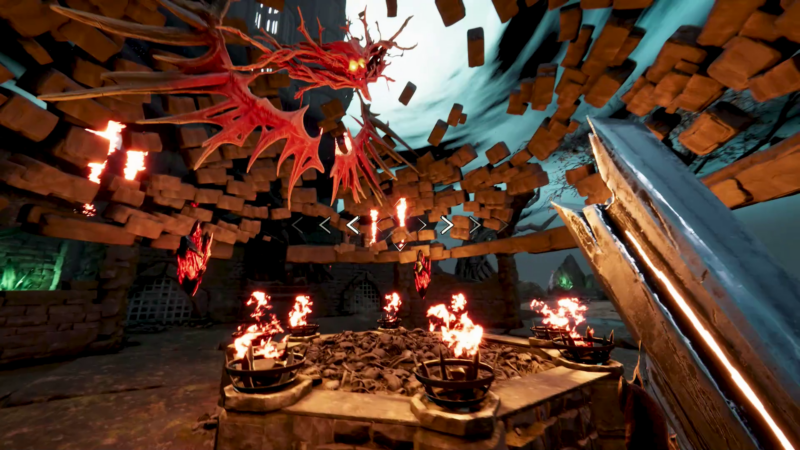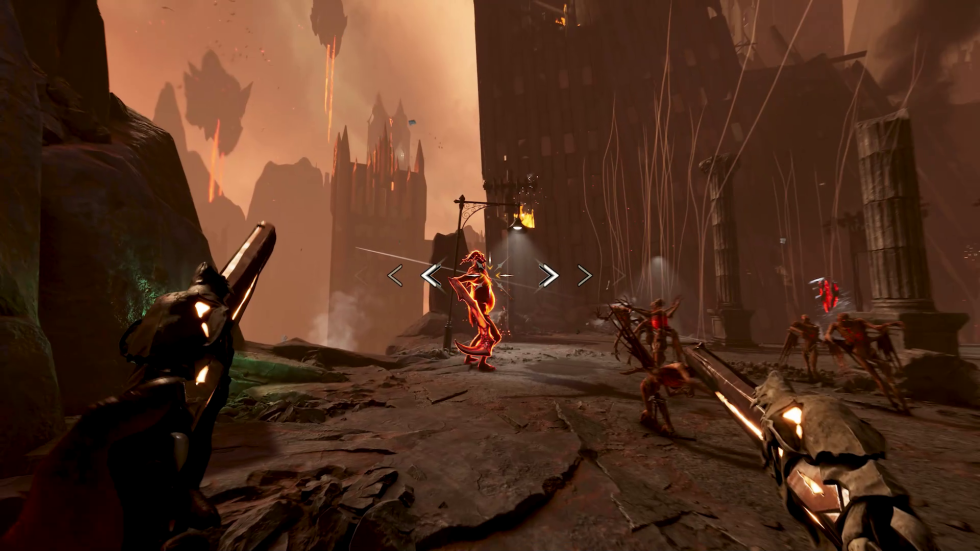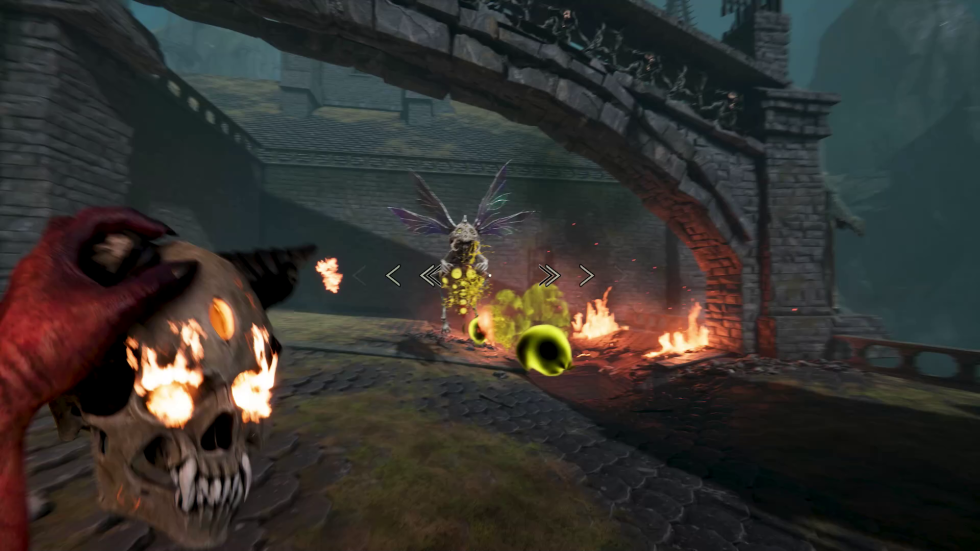
[Update, June 9: The Metal: Hellsinger demo described in the below article has now gone live as a free demo via Steam.]
When video games infuse music, rhythm, and tempo into their action, I'm typically first in line to try them. That's been the case since PaRappa the Rapper kicked and punched its way into my heart in late 1996. Ever since, I've strapped into VR, tested plastic instruments, visited elaborate arcades, and rocked out with the biggest and smallest experiments in the genre.
Through the decades, however, my dream peanut butter-and-chocolate gaming combo has yet to succeed: a first-person rhythm game. The indie roguelike BPM: Bullets Per Minute tried nailing that fusion in 2020 only to falter because, apparently, delivering Doom-like combat to the beat requires a graceful touch.
Hence, I was dubious when another contender to this unclaimed throne, Metal: Hellsinger, was announced as a similar "slay demons to the rhythm of heavy metal" quest. Its developers at Swedish upstart The Outsiders seem to understand that apprehension ahead of its launch on PC, Xbox, and PlayStation by the end of 2022, as they've emerged with the exact hands-on demo needed to put an exclamation point on their pitch. This game isn't just better than BPM. As much as I've loved the modern Doom reboot series, I'm wondering if Metal: Hellsinger might become the most headbang-worthy demon-blasting game ever.
Tempo of the beast

BPM deserves credit for nailing some basics: take overcharged weapons into a demonic landscape, then shoot, reload, and dodge to the beat of background music in battles against otherworldly creatures. Metal: Hellsinger follows that path and uses a BPM-like on-screen interface of tick marks converging mid-screen like a macabre metronome.
But this newer game differs in significant ways. Metal: Hellsinger has bespoke, pre-made levels instead of BPM's randomly generated underground caverns. As a result, Metal: Hellsinger approaches Doom Eternal's aesthetic, whether because a battling arena includes carefully laid jump-and-dash paths or between-combat moments let players run through mood-setting passages where vistas stretch to a grim, black-and-orange horizon.

In this demo's case, levels eventually lead to an impressive boss encounter, where waves of enemies are puppeteered by a monstrous, hovering beast (seen at the top of the article) who unleashes waves of "bullet hell" attacks. By the time you've gotten the hang of battling to the beat with the game's first four weapons, this boss pushes you to swap between those implements and contend with a satisfying difficulty spike.

At least in this limited demo, the game's rhythmic action feels better tuned for solid combat flow than the all-too-fast pace of BPM. I wouldn't be surprised if later Metal: Hellsinger levels resemble an average death metal drummer's double kick-drum setup, but its satisfying introductory levels land on a steadier "groove metal" tempo akin to Black Sabbath or Pantera. Every time you ready a sword swipe or conjure another fiery spell (as launched from a glowing skull in your hands), the music makes room for a slight, satisfying pause, as if you had a moment to twirl a drumstick before slamming it on a snare.
Wearing a demo out, like shareware from the '90s
You can attack outside the beat if you want, but the game rewards battling to the tempo in a few significant ways. First is the brutal impact of attacks within a "good" or "perfect" tempo window, matched with a louder, crunchier sound effect and clear visuals indicating that your timely attacks did more damage. However, more importantly for this game's metal pastiche is the reward for keeping your hit multiplier intact, which stacks more "layers" of a background song's mix. The better you do, the more rhythm guitar, bass, and additional drum effects emerge—while a maxed-out tempo meter toggles a song's vocal mix, which in this demo's case alternates between Cookie Monster growling and Evanescence-like howls above the demonic reverie.
-
Step one: line up your shot.
-
Step two: shoot to the beat, which will produce a more explosive attack (as indicated by a higher damage number).
The game's publishers at Funcom are already eager to sell the final product's jam-packed soundtrack, which includes members of reasonably known bands like Trivium, Lamb of God, and System of a Down. The demo only contains two songs to blast along to, and one level, unfortunately, stretches a single song a bit too long—forcing its vocal refrain to repeat if you stick to a "16x" rhythm combo. But its developers understand where to emphasize the metal instrumentation's mix and where to carve frequency space so that in-rhythm attacks deliver a punchy impact to the full audio mix. As a result, I'm reluctantly optimistic that the catchy, driving metal in this demo is indicative of how rocking the final product will sound.
The demo for Metal: Hellsinger landed in my inbox three weeks ago, and its single level and boss encounter take about 15 minutes to complete. Yet I've found myself replaying the heck out of it—as if I were a teen in the '90s, clutching a precious shareware version of Doom 1 and saving money to eventually buy the rest of the game.

In my three weeks, I've only grown more fond of the four weapons available thus far (sword, fire spell, shotgun, and dual pistols). I've also gotten better at reloading and dodging to the beat—and spreading my damage so that I can more consistently land "killing blow" taps to get much-needed health at higher difficulties. I've also learned how consistently swapping weapons lets players build different meters so that they can more frequently drop crucial super attacks, including a lighting spire and a temporary sentry gun that can chew through waves of pesky peons.
And I've appreciated one meaningful distinction from BPM: enemy generation, placement, and AI. Instead of making players pick out flocks of scattered enemies, especially ones flying in the air, Metal: Hellsinger's waves of enemies let players focus on the background music's tempo. There's plenty of first-person challenge to juggle here in terms of contending with varied AI per enemy type—some rush you, others hang back with ranged blasts—and doubling down on dodge-to-the-beat mechanics in ways that feel satisfying, not slapdash.
Will the final game maintain a single level's fun-to-replay momentum? That will depend on factors I haven't tested thus far, including additional weapons, new songs, and questions like whether enemy diversity will pump new life into later levels or whether the audio team figures out how to handle repeating vocal tracks in the musical mix. I'm at least convinced that I want to try the final game and find out, whenever Funcom decides that will happen later this year.
reader comments
47